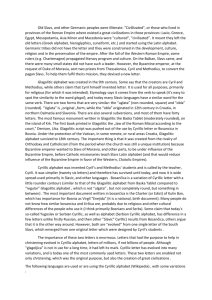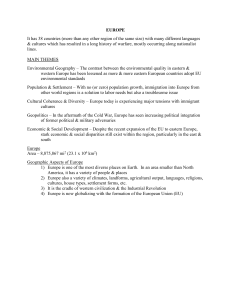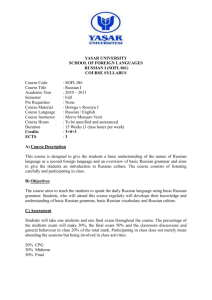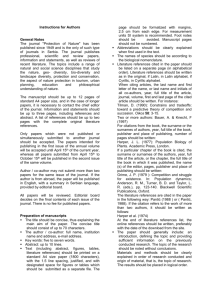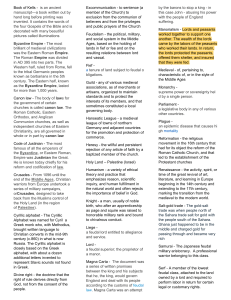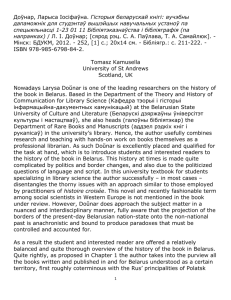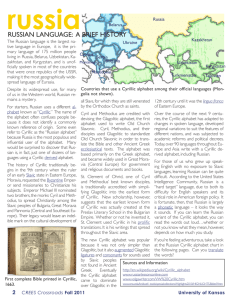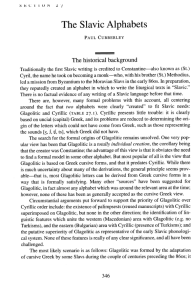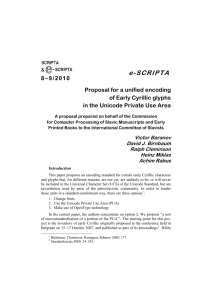Proposal for the Generation Panel for the Cyrillic Script Label
advertisement
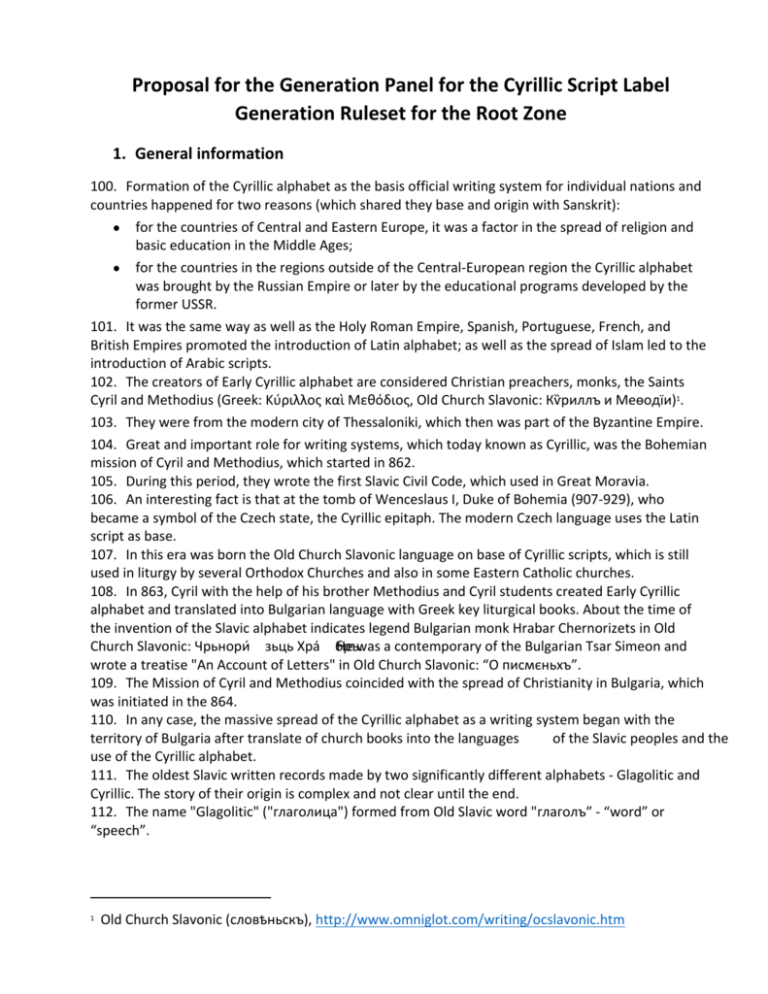
Proposal for the Generation Panel for the Cyrillic Script Label Generation Ruleset for the Root Zone 1. General information 100. Formation of the Cyrillic alphabet as the basis official writing system for individual nations and countries happened for two reasons (which shared they base and origin with Sanskrit): x for the countries of Central and Eastern Europe, it was a factor in the spread of religion and basic education in the Middle Ages; x for the countries in the regions outside of the Central‐European region the Cyrillic alphabet was brought by the Russian Empire or later by the educational programs developed by the former USSR. 101. It was the same way as well as the Holy Roman Empire, Spanish, Portuguese, French, and British Empires promoted the introduction of Latin alphabet; as well as the spread of Islam led to the introduction of Arabic scripts. 102. The creators of Early Cyrillic alphabet are considered Christian preachers, monks, the Saints Cyril and Methodius (Greek: Κύριλλος καὶ Μεθόδιος, Old Church Slavonic: Кѷриллъ и Меѳодїи)1. 103. They were from the modern city of Thessaloniki, which then was part of the Byzantine Empire. 104. Great and important role for writing systems, which today known as Cyrillic, was the Bohemian mission of Cyril and Methodius, which started in 862. 105. During this period, they wrote the first Slavic Civil Code, which used in Great Moravia. 106. An interesting fact is that at the tomb of Wenceslaus I, Duke of Bohemia (907‐929), who became a symbol of the Czech state, the Cyrillic epitaph. The modern Czech language uses the Latin script as base. 107. In this era was born the Old Church Slavonic language on base of Cyrillic scripts, which is still used in liturgy by several Orthodox Churches and also in some Eastern Catholic churches. 108. In 863, Cyril with the help of his brother Methodius and Cyril students created Early Cyrillic alphabet and translated into Bulgarian language with Greek key liturgical books. About the time of the invention of the Slavic alphabet indicates legend Bulgarian monk Hrabar Chernorizets in Old Church Slavonic: Чрьнори́зьць Хра́бръ. He was a contemporary of the Bulgarian Tsar Simeon and wrote a treatise "An Account of Letters" in Old Church Slavonic: “О писмєньхъ”. 109. The Mission of Cyril and Methodius coincided with the spread of Christianity in Bulgaria, which was initiated in the 864. 110. In any case, the massive spread of the Cyrillic alphabet as a writing system began with the territory of Bulgaria after translate of church books into the languages of the Slavic peoples and the use of the Cyrillic alphabet. 111. The oldest Slavic written records made by two significantly different alphabets ‐ Glagolitic and Cyrillic. The story of their origin is complex and not clear until the end. 112. The name "Glagolitic" ("глаголица") formed from Old Slavic word "глаголъ₺ ‐ “word” or “speech”. Old Church Slavonic (словѣньскъ), http://www.omniglot.com/writing/ocslavonic.htm 1 113. By alphabetical Glagolitic composition is almost identical with the Cyrillic alphabet, but differed sharply from her form letters. It was found that the origin of the Glagolitic letters are mostly connected with the Greek minuscule alphabet, some letters are based on the Samaritan and Hebrew letters. 114. The Unicode block for Glagolitic is U+2C00–U+2C5F (see Fig. 1). 2 115. Glagolitic and Cyrillic some time coexisted. Then began the process of the gradual replacement of the Glagolitic books in Cyrillic, and as result ‐ Bulgarian Glagolitic letter forgotten. Glagolitic was widespread in the Middle Ages in Czech and Dalmatia, where the Church was oriented towards Rome. 116. Cyrillic is spread in the Balkans, as well as became virtually the only Slavic letters' system, which was used in daily life, in areas that have been colonized by first Slavic people in East Europe, and then ‐ for the other nations ‐ from the Urals up to the Pacific. 1.1. Panel Diversity 117. The Cyrillic Generation Panel have aim – forming recommendations for MSR and LGR. 118. The Cyrillic Generation Panel gathers experts from a variety of backgrounds (bringing varied linguistic and technical perspectives ) and covering a wide variety of various languages which using 108 scripts. 119. It is not possible in framework of exist possibilities of Cyrillic Generation Panel covered all languages, more than 9 languages group, and more than 100 Cyrillic scripts which they used. It is not possible to include one expert per language as Cyrillic script used for a significant number of languages. 120. In this case, Cyrillic Generation Panel is focused on main languages, which are official languages in the countries or are recognized and specified as non‐minority national or regional languages (for example, Serbian language in Bosnia and Herzegovina or Russian language in Ukraine or in Uzbekistan). In addition, Cyrillic Generation Panel considers the scripts that will be to used in already delegating gTLD/ccTLD or are planned for delegation of new IDN gTLD/ccTLD with Cyrillic. 121. Taking into account the great diversity of Cyrillic scripts, which can be distinguished into four groups, it makes sense to organize 4 small working groups ‐ "the Balkans", "Russian‐Ukrainian‐ Belarusian", "Central Asia" and "Mongolia". Some of the experts also have knowledge of other scripts. 122. The Cyrillic Generation Panel includes of members from very different perspectives, representing national and regional policy makers, technical community in general, technical community directly working with the DNS (e.g. registries ), IDN, DNSSEC, and members with experience with local language computing using Unicode and specifically IDNs. 123. Geographically, the GP for Arabic script has 19th members from across the relevant regions, including West, Central and East Europe, Middle Asia and Mongolian regions. The members belong to 11th different countries from these regions. 1.2. Script for which the panel is to be established Table 1: List the ISO 15924 script code (http://www.unicode.org/iso15924/iso15924‐codes.html) Code N° English Name Nom français Property Value Alias Date Cyrl 220 Cyrillic cyrillique Cyrillic 2004‐05‐01 Cyrs 221 Cyrillic (Old Church Slavonic variant) cyrillique (variante slavonne) 2004‐05‐01 1.3. Principal languages using that script 3 Table2: List Language code and name for each (from ISO 639‐3)2 639‐3 639‐1 639‐2B Native eng bel be bel Беларуская Belarusian bul bg bul Български Bulgarian kaz kk kaz Қазақша Kazakh kir ky kir Кыргыз Kyrgyz mon mn mon Монгол Mongolian mkd mk mac Македонски Macedonian rus ru rus Русский Russian srp sr srp Српски Serbian srp sr srp Crna Gora Montenegro tgk tg tgk тоҷикӣ Tajik tuk tk tuk Түркмен Turkmen ukr uk ukr Українська Ukrainian uzb uz uzb Ўзбек Uzbek 1.4. Geographic territories or countries with significant user communities for the script 124. Territory – is from Serbia, Montenegro, Macedonia, Bulgaria, Bosnia and Herzegovina in Europe to Mongolia in Asia via Balkan peninsula to Belorussia, Ukraine, Russia, Kazakhstan, Turkmenistan, Uzbekistan, Kyrgyzstan and Tajikistan in Middle Asia3. ISO 639 Code Tables, http://www‐01.sil.org/iso639‐3/codes.asp Cyrillic alphabet distribution, 2 3 http://commons.wikimedia.org/wiki/File:Cyrillic_alphabet_distribution_map.png 4 Figure 2: Areal of Cyrillic Legend: is the only official orthography is the only official orthography, but others are recognized for national or regional languages Figure 2: Geographic territories spread of Cyrillic 125. Areal include 13 countries and 108 scripts. 1.5. The related scripts 126. Language groups that use the Cyrillic alphabet: Indo‐European languages Caucasian languages Sino‐tibetsky languages Chukchi and Kamchatka languages Mongolian languages Tungus languages Turkic languages Ural languages Individual languages ‐ Aleutian, Nivkhs, Ket, Eskimos, Yukaghir languages 1.6. Some features of subject 127. Montenegrin. 128. Montenegro’s Constitution defines Cyrillic and Latin scripts as equal. Based on this fact, DoMEn (national registry) plan to add two new chars in both scripts at the same time when 2 chars become present as Unicode Cyrillic point codes, effectually implementing IDN at second level Code points Unicode Ź ź Ś ś U+0179 U+017A U+015A U+015B In Cyrillic scripts the Code points shapes are known: Latin Ź ź Ś ś Cyrillic З́ з́ С́ с́ 129. Example: "Śutra" equal "Sjutra", translated on English "tomorrow", "Źenica" equal "Zjenica", translated of English – Latin "Iris" (colored visible part of eye). 130. Despite the fact that the procedure with Unicode as Cyrillic letters for these code points has been initiated, in present period they can not be the consideration subject of Cyrillic Generation Panel. 131. Ukrainian and Belarusian. 132. The Ukrainian and Belarusian languages present code point “apostrophe” (U+02BC) which play role of letter – not punctuation sign, and: x In Ukrainian performs the same function as Russian letter «ь» (U+044C Cyrillic Small letter Soft Sign). ; x in Belarusian performs the same function as Russian letter «ъ» (U+044A Cyrillic Small letter Hard Sign) 5 133. These letters “ ʼ ” can’t (cannot) be the first or last letter of any word in Ukrainian and Belarusian, only in the middle. 134. This code point (U+02BC) on Cyrillic was included in both IDN Tables for .УКР IDN ccTLD4 and .БЕЛ IDN ccTLD5. 135. Example: can’t = can not мʼясо != мясо English sign English Ukrainian letter Russian 136. Using Uppercase and Lowercase Unicode code points in Cyrillic 137. According of RFC 5892 and IDNA 2008 Uppercase letters are disallowed. But there are important and controversial aspects of practical using by customers the different registers in Internet‐applications. 138. Unfortunately, these applications allow as well as the Lower‐ and Upper‐cases. At the same time, we are seeing a lot of emails ‐ part of them may classify as a spam and/or fishing ‐ contain in text an IDN URL/URI with using and Uppercase and Lowercase letters 139. For example, in Lowercase Latin code point "m" (U+006D) and Cyrillic code point "м" (U+043C) is the "not‐confusion variant", but in the Uppercase code point "M" (U+004D) and Cyrillic code point "M" (U+041C) ‐ the same letters for customers and "confusion variant" for them. Uppercase: The same letters which have “confusion variant” for users M (U+004D) Latin = (in the perceptio n of the user) М (U+041C) m (U+006D) Cyrillic Latin Uppercase: The same letters which have “confusion variant” for users A (U+0041) C (U+0043) Latin = (in the perceptio n of the user) Latin = (in the perceptio n of the user) != (in the perceptio n of the user) м (U+043C) Cyrillic Lowercase: The different letters which have “confusion variant” for users А (U+0410) a (U+0061) С (U+0421) c (U+0063) Cyrillic Latin TLD­string in Uppercase: The same letters which have “confusion variant” for users .MAC Lowercase: The different letters which have not “confusion variant” for users = (in the perceptio n of the user) а (U+0430) с (U+0441) Cyrillic TLD­string in Lowercase: The different letters which have not “confusion variant” for users .МАС .mac Cyrillic Latin != (in the perceptio n of the user) .мас Cyrillic 140. Examples with delegated IDN ccTLD and IDN gTLD in Cyrillic. https://registry.tci.net.ua/Ukrainian_IDN_Table_v3.txt http://www.cctld.by/idn‐table‐bel.html 4 5 6 141. The fact of delegation .укр (.УКР) ccTLD has excluded the possibility delegation for string .ykp (.YKP). 142. The fact of delegation .рус (.РУС) IDN gTLD has excluded the possibility delegation for string .pyc (.PYC). 143. Because the cases are related to evaluation and delegation TLD‐string, the questions are arise: 144. Should the Cyrillic Generation Panel take into consideration all possible confusion variants based on existing facts of TLD‐strings delegation and possibility the future delegation of similar cases? 145. Should the Cyrillic Generation Panel consider all combination of Upper‐/Lower‐cases in Cyrillic/Latin/Greek scripts if the possibility of confusion variants can arise at the stages of TLD‐string evaluation or delegation? 146. Taking into account the fact that “user aspect” in this sense: (1) does not have a decision at the level of technical implementation of Internet applications, (2) not covered by requirements of RFC 5892 and IDNA 2008, (3) assumes that will require consideration the options of the Label Generation Rules, (4) assumes that will require consideration of the relevant features during the process of TLD‐ string delegation, the Cyrillic Generation Panel should to consider the Uppercase Unicode Cyrillic code points too. 7 8 147. Cyrillic structurally and historically was related with Latin and Greek but more detail should examined during work of Panel. Table 3: The source of the Greek tables for search cross‐script confusion variants “Cyrillic‐Greek“ Greek Capital Greek small Α Β Γ Δ Ε Ζ Η Θ Ι Κ Λ Μ Ν Ξ Ο Π Ρ Σ Τ Υ Φ Χ Ψ Ω α β γ δ ε ζ η κ λ μ ο σ τ υ φ χ ψ ω θ ι ν ξ π ρ Table 5: The source of the Latin tables for search cross‐script confusion variants “Cyrillic‐Latin“ Latin (Basic) Capital A B C D E F G H I J K L M N O P Q R S T U V W Y X Latin (Basic) small a b c d e f g h j k l m n o p q r s t u w y x À Á Â Ã Ä Å Æ Ç È É Ê Ë Ì Í Î Ï Ð Ñ Ò Ó Ô Õ Ö Ø Ù Ú Û Ü Ý Þ à á â ã ä å æ ç è é ê ë ì í î ï ð þ Latin (IDN­ Extended) Capital Latin (IDN­ ß Extended) small i ñ ò ó v ô õ 9 ö ø ù ú û ü ý ÿ 2. Proposed initial composition of panel 2.1. Panel Chair and Members (with Expertise) Table 4: The details of Members’ relevant expertise # 1 Name, Surname Position Country Organization Vladimir Shadrunov independent expert United Kingdom Vladimir Consulting Ltd. Mirjana Tasic Adviser for Strategy and Development independent expert Serbia Serbian National Internet Domain Registry ‐ RNIDS 2 Nelly Stoyanova 3 Yulia Morenets Bulgaria independent France expert (Representativ e of TaC) Ukrainian .УКР Ukraine Registry Together against Cybercrime Dmitry Kohmanyuk Ukrainian .UA Registry Ukraine Hostmaster Dušan Stojičević Chairman of the Managing Board independent expert Serbia Serbian National Internet Domain Registry ‐ RNIDS Ukrainian Parliament Yashar Hajiyev independent expert Azerbaijan Azerbaijan Technical University Enkhbold Gombo Mongolian Mongolia Datacom Co., Ltd. 4 Yurii Kargapolov 5 UANIC 6 7 Oleksandr Tsaruk Ukraine 8 9 10 Languages (native: , communication:) native: Russian, communication: English native: Serbian communication: English native: Bulgarian, communication: English native: Russian communication: English, French native: Russian, Ukrainian communication: English native: Ukrainian, Russian communication: English native: Serbian communication: English native: Ukrainian, Russian communication: English native: Azerbaijan communication: English native: 10 Registry Daniel Kalchev Bulgarian Registry Bulgaria Register.bg Alexander Ilin Russian Registry Russia TCI LLC Sanja Simonova Macedonian Registry Macedonia Almaz Bakenov Program Director, Computer Science Department Chair of the Executive committee Ukrainian .УКР Registry Kyrgyz Republic Macedonian Academic And Research Network‐ MARnet American University of Central Asia Sergey Povalishev 12 13 14 15 Iliya Bazlyankov Bulgaria CORE Association Ukraine UANIC Belarusian Registry Belarus Reliable Software Inc. Alexei Sozonov .РУС gTLD Registry Russia Rusnames Limited Predrag Lesic .me ccTLD Registry Montenegr o DoMEn doo 16 Yurii Honcharuk 17 18 19 20 Mongolian; communication: English native: Bulgarian, communication: English, Russian native: Russian, communication: English native: Macedonian, communication: English native: Kyrgyz, Russian communication: English native: Bulgarian, Communication: English native: Russian, Ukrainian communication: English native: Russian, Belarusian communication: English native: Russian communication: English native: Montenegrin communication: English 11 Table 6: The details of organizations represented in Cyrillic Generation Panel # Organization UANIC URL http://uanic.net http://усиц.укр Country Ukraine Brief details Administrator of .УКР IDN ccTLD 2. 3. 4. 5. 6. Hostmaster RNDIS Register.BG MAR‐net Together against Cybercrime International http://hostmaster.ua http://www.rnids.rs www.register.bg http://marnet.mk www. againstcybercrime. org Ukraine Serbia Bulgaria Macedonia Headquarter based in France 7. Datacom Co., Ltd. Mongolia 8. Ukrainian Parliament www.datacom.mn www.domain.mn www.mon.mn www.rada.gov.ua Registry Operator of .UA ccTLD Administrator of .СРБ IDN and .RS ccTLD Administrator of .БГ IDN and .RS ccTLD Administrator of .МКД IDN and .MK ccTLD Non–profit making organization working in the field of: Cybercrime Cybersecurity Child online protection The organisation provides : Legal assistance Research and Capacity building Registry of ccTLD .MN and Registry of IDN “.мон/xn‐‐l1acc” 9. Azerbaijan Technical University http://aztu.edu.az Azerbaijan 10. CORE Association http://corenic.org Switzerland 11. Reliable Software Inc. Rusnames Limited American University of Central Asia Technical Center of Internet http://cctld.by/ http://домены.бел/ http://rusnames.ru/ Belarus Russia Chief adviser of Committee on Informatization and Informational Technologies at Verkhovna Rada of Ukraine Azerbaijan Technical University is collaborated with UN, UNESKO, TRASEKA, other relevant structures of International Organizations and working in: Cybercrime Cybersecurity Research and Capacity building CORE Internet Council of Registrars Administrator of .САЙТ and .ОНЛАЙН IDN gTLD Technical administrator of .БЕЛ IDN and .BY ccTLD Administrator of .РУС IDN gTLD www.auca.kg Kyrgyz Republic Program Director, Software Engineering Department www.tcinet.ru Russia Technical Center of the Internet provides backbone services to the registries and runs the domain registration services of Russia's national domains (.RU and .xn‐‐p1ai), .SU, . xn‐‐d1acj3b, and several others gTLD. Administrator of .ME ccTLD http://domain.me/ Montenegro 1. 12. 13. 14. 15. Ukraine DoMEn doo 12 2.2. Relationship with Past Work or Working Groups 148. Work on Cyrillic script IDNs started in early 2000s. Some of the members have been involved with Cyrillic script IDNs since then. Many have been members of Cyrillic Case Study Team formed in 2011, and have been active in IDNs processes. 149. A few participants of the Cyrillic Generation Panel were members of the ICANN Cyrillic Case Study Team during 20116. Report and public comment was published 14 November 2011 and are available7. 150. These members bring the context of early discussions, issues and solutions to the Panel. 151. The members have also been active at relevant ICANN forums, including part of the Variant Issues Project and the follow up work on IDNs and variants at ICANN. 3. Work plan 3.1. Listing of significant milestones 152. The Generation Panel intends to divide the work on LGR for the Root zone in four stages. These are organized as follows: 1. Development and Finalization Principles Inclusion, Exclusion or Deferral of Code Points 2. Development and Finalization of Rules Variants for inclusion of the Code Points 3. Development and Finalization of Whole Label Rules 4. Development and Finalization of LGR Documents for Cyrillic Script and Submission to ICANN 153. Each phase will have its own characteristics in the consideration and study of the subject. In any case, formation the subject of consideration for each stage should begin with an analysis of existing information regarding Cyrillic Code Points and best practices of other GPs, which work with Arabic, Latin and other scripts. 154. The general principle of the Cyrillic Generation Panel operation activity is that at each stage will interact with Integration Panel to get its feedback, as these principles are finalized. After the principles are finalized, in the second phase the data (character repertoire, variants, and labels ) will be analyzed to make concrete decisions 155. After the principles are finalized, in the second phase the data (character repertoire, variants, and labels ) will be analyzed to make concrete decisions. Finally, at each stage, the output will be released to the wider community (including ICANN and IP ) for feedback. Each of the four tasks above will be finalized after one or more public comment periods. 156. It is anticipated that the work will take at least one calendar year. The tentative work plan is depicted in the table below. This Plan reflects and involves that some sub phases during all work will be not only linear, but also in parallel. 157. It is anticipated that the work will finish in a calendar year, the actual time may vary based on the feedback received by the community and the IP at various stages and phases of the work and may go beyond 2015. Variant Issues Project ‐‐ Cyrillic Case Study Team, https://www.icann.org/news/announcement‐ 2011‐10‐06‐en 7 Cyrillic Case Study Team Report “IDN Variant TLDs ‐‐‐ Cyrillic Script Issues”, https://www.icann.org/en/topics/new‐gtlds/cyrillic‐vip‐issues‐report‐06oct11‐en.pdf 6 13 158. For more effective research and work with a subject the small working groups will be created; structure and work rules for these small work groups should be agreed previously. The work aim of the small working groups consists in detailed studying of single questions which are related to a subject of a concrete stage. The principle of formation of the small working groups – self‐ organization of the interested Panel's participants who send the Chairman Panel the relevant e‐mails. According to demands of coordinators of the small working groups the Chairman of GP organizes channels of communication (e‐mail, conference‐calls etc.). After achievement of goals for a concrete stage the small working groups can be reformatted or dismissed 3.2. Proposed Schedule of Meeting and Teleconferences 159. Most of the work will be accomplished through the ICANN email list ("cyrillicgp@icann.org" cyrillicgp@icann.org). The task force will be holding regular teleconferences every two weeks, for the period of the work. In addition, the task force will also organize face‐to‐face meetings, tentatively during the discussions on variants (in July 2015) and then towards the end of the work (in December 2015). 3.3. Sources of Funding for Travel and Logistics 160. Foremost, all the members of the task force will be volunteering their time for this purpose. 161. The work has travel and logistic support requirements. ICANN will support the logistics of the group (e.g. conference calls, assisting in coordination, wiki page for posting information, etc.) to a limited extent. Members of the working group are encouraged to find sources of funding to attend face‐to‐face meeting(s). ICANN might be able to fund a limited number of those members who are active in the proceedings of the working group, and will also provide support for remote participation for the members not able to attend the meeting(s) . 3.4. Need for ICANN Provided Advisors 162. Cyrillic Generation Panel is needed advisors at first stages during period of earlier discussions and experience. ICANN will be requested for advisors, if need arises during the discussions for the development of the LGR for the Root zone. 3.5. Suggested Plan and Timeline № Task 1.1 Formation first draft of “Proposal for the Generation Panel for the Cyrillic Script Label Generation Ruleset for the Root Zone” Preliminary Code Points Analysis 1.2 Subtask Filing in all of the tables in document; formation of the subject base for next steps Deadline 04.01.201 5 Analysis of the National Cyrillic 04.01.201 Alphabet to identify cases of 5 confusion Code Points relative to the Latin and Greek Scripts Responsible executive Small working groups on the National Cyrillic Scripts (for each National Script ‐ small working group) Small working groups on the National Cyrillic Scripts (for each National Script ‐ small working group) 14 1.3 Preparation of own confusion 04.24.201 tables (on base native alphabets) 5 with Latin and Greek scripts 1.4 Preparation of consolidated confusion tables in form of the summary table for Cyrillic scripts Definition of Inclusion, Exclusion or Deferral Principles The preparation and formation of summary document on Code Points of Cyrillic Scripts which should be included, excluded or deferred (as basis for Label Generation Ruleset ‐ LGR) for TLD labels Principles for what is a Variant (as a part of LGR) of including of the Code Points within Cyrillic script Principles for what is a Variant (as a part of LGR) of confusing the Code Points between Cyrillic script and Greek/Latin scripts Public comments on variants 2.1 2.2 Principles Inclusion, Exclusion or Deferral for Code Points 3.1 Rule Variants Analysis 3.2 3.3 3.4 3.5 4.1 5.1 5.2 5.3 Whole Label Evaluation (WHL) Rule Analysis Finalization of LGR proposal for Cyrillic script The preparation and formation of summary document on Variants Code Point Level Analysis for Cyrillic Script for Inclusion in LGR for the Root Zone Analysis for WLE Rules (if any) The preparation and writing of the final report Public comments Finalization of report after comments 04.28.201 5 06.30.201 5 Small working groups on the National Cyrillic Scripts (for each National Script ‐ small working group) Cyrillic GP Cyrillic GP Cyrillic GP 07.30.201 5 Small working group #1 07.30.201 5 Small working group #2 08.28.201 5 09.21.201 5 Open for community Cyrillic GP 10.01.201 5 Cyrillic GP 11.09.201 5 Cyrillic GP 12.01.201 5 12.18.201 5 12.25.201 5 Cyrillic GP Open for community Cyrillic GP 15

